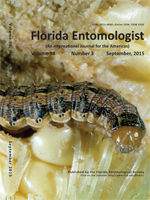Host plant records are reported for 5 species of Anastrepha (Diptera: Tephritidae) collected from wild and commercial fruit species in the Mexican state of Quintana Roo.
Anastrepha fruit flies (Diptera: Tephritidae) are considered among the most important pests of fruit crops. In Quintana Roo, Mexico, 7 Anastrepha species have been recorded, including A. ampliata Hernandez- Ortiz, A fraterculus (Wiedemann), A. hamata (Loew), A. ludens (Loew), A. obliqua (Macquart), A. serpentina (Wiedemann), and A. striata Schiner (Hernández-Ortiz 1992; Hernández-Ortiz et al. 2002, 2012). These records are based principally on specimens collected by traps. The purpose of the present work was to determine the composition of Anastrepha species associated with natural and introduced hosts in Quintana Roo.
Fruit samples were collected in 6 counties of Quintana Roo (Bacalar, Felipe Carrillo Puerto, José María Morelos, Othón P. Blanco, Solidaridad, and Tulum) from Feb to Sep 2013. Fruits were collected directly from plants or from individual fruits that had fallen onto the ground underneath the canopy of commercial and backyard orchards or in the wild. The species of fruit collected depended on their seasonal availability in the study areas.
Each fruit was placed individually into a plastic bag, and the bag was labeled with the collection data. The bagged fruits were transported to Comité Estatal de Sanidad Vegetal de Quintana Roo, which is the local Plant Health Government Agency laboratory in Chetumal, Quintana Roo. Each fruit sample was weighed individually, and ripe fruits were dissected to extract larvae. The rearing methods were according to García-Ramírez et al. (2010).
Host plant species were determined using the keys of Peña-Chocarro & Knapp (2011) and Rodríguez et al. (2009). Details on the localities of each plant can be found in the Supplementary Material for this article in Florida Entomologist 98(3) (Sep 2015) online at http://purl.fcla.edu/fcla/entomologist/browse. Fruit fly species were determined using the Hernández-Ortiz (1992) key. The total number of larvae per kilogram of fruit and number of larvae per fruit were calculated for each fruit fly species.
Five fruit fly species were reared from the fruits of 12 of the 18 plant species that were sampled (Table 1). They were collected principally from species of Anacardiaceae, Rutaceae, and Sapotaceae, whereas no tephritids were reared from the sampled species of Chrysobalanaceae, Combretaceae, and Malpighiaceae fruits. Host associations are consistent with previous reports (Norrbom & Kim 1988; Norrbom 2004). Anastrepha ludens was the most reared species, but was reared only from Citrus fruits (Rutaceae). Anastrepha obliqua was reared from 3 host species in 3 families, A. striata from 2 species in 2 families, and A. serpentina from 3 species of Sapotaceae, whereas A. hamata was reared only from Pouteria campechiana (Kunth) Baehni (Ericales: Sapotaceae), commonly known as canistel or yellow sapote. Anastrepha ampliata and A. fraterculus were not collected in this study, probably because their hosts have irregular fruiting phenologies that did not coincide with the collection period. Spondias purpurea L. (Sapindales: Anacardiaceae) is an uncommon host cited for A. striata, but its host range includes species of Annonaceae, Anacardiaceae, Apocynaceae, Arecaceae, Calophyllaceae, Combretaceae, Ebenaceae, Euphorbiaceae, Fabaceae, Lauraceae, Malpighiaceae, Melastomataceae, Myrtaceae, Oxalidaceae, Passifloraceae, Rosaceae, Rubiaceae, Rutaceae, Sapotaceae, Solanaceae (Korytkowski & Ojeda 1968; Norrbom 2004; Castañeda et al. 2010; Marsaro et al. 2011; Jesus-Barros et al. 2012), and it is possible that S. purpurea could be a minor host of A. striata in Quintana Roo or this oviposition event would be the result of unusual circumstances.
Five fruit species yielded over 20 fruit fly larvae per kilogram of sampled fruit, including Cordia dodecandra DC. (Boraginales: Boraginaceae), Manilkara zapota (L.) P. Royen (Ericales: Sapotaceae), P. campechiana, Psidium guajava ‘pera' (Myrtales: Myrtaceae), and S. purpurea. Less than 5 specimens per kilogram of fruit were recorded in the remaining fruit species, except P. guajava ‘criolla' and Chrysophyllum cainito L. (Ericales: Sapotaceae). We recorded 10.7 to 17.1 larvae per fruit of each of the varieties of Mangifera indica L. (Sapindales: Anacardiaceae) and Citrus sinensis (L.) Osbeck (Sapindales: Rutaceae) (Table 1). Only Citrus aurantium L. (Sapindales: Rutaceae) had 2 different species of Anastrepha, A. ludens and A. obliqua, that emerged as adults during the collection period. Information included in this work gives the first data of host relationships of Anastrepha species in Quintana Roo, Mexico. Further study of host plant usage, infestation rates, phenology, and host pattern distribution is critical for the successful monitoring and control programs of these fruit flies (Jesus-Barros et al. 2012).
Anastrepha species composition varied between counties sampled, from 2 to 4 species by county (Table 2). Anastrepha ludens was collected in all the counties visited, except in Solidaridad. Anastrepha hamata was collected only in the county of Felipe Carrillo Puerto. These differences could be the result of the species of fruit collected, the fruit availability, and the collection effort.
We thank the technical staff of Comité Estatal de Sanidad Vegetal de Quintana Roo for field support. JMSA gratefully acknowledges receiving a CONACYT fellowship (#376702).
Table 1.
Anastrepha species larvae found infesting fruits of various species of native and introduced collected trees from 5 counties (Bacalar, Felipe Carrillo Puerto, José María Morelos, Othón P. Blanco, Solidaridad, and Tulum) in Quintana Roo, Mexico, collected from Feb to Sep 2013.

Table 2.
Anastrepha species reared from various species of native and introduced collected trees from 5 counties in Quintana Roo, Mexico, collected from Feb to Sep 2013.

References Cited
Notes
[1] Supplementary material for this article in Florida Entomologist 98(3) (Sep 2015) is online at http://purl.fcla.edu/fcla/entomologist/browse





